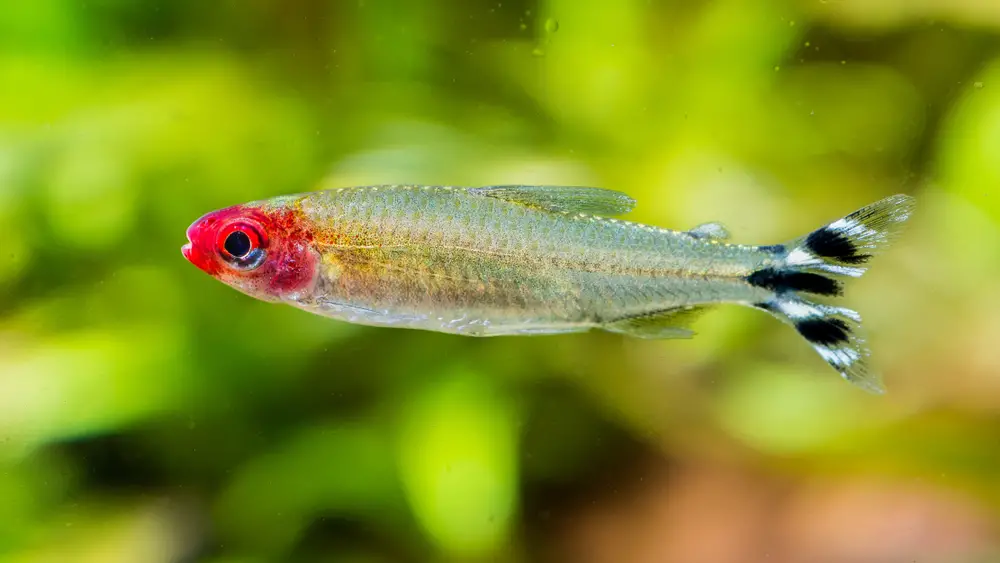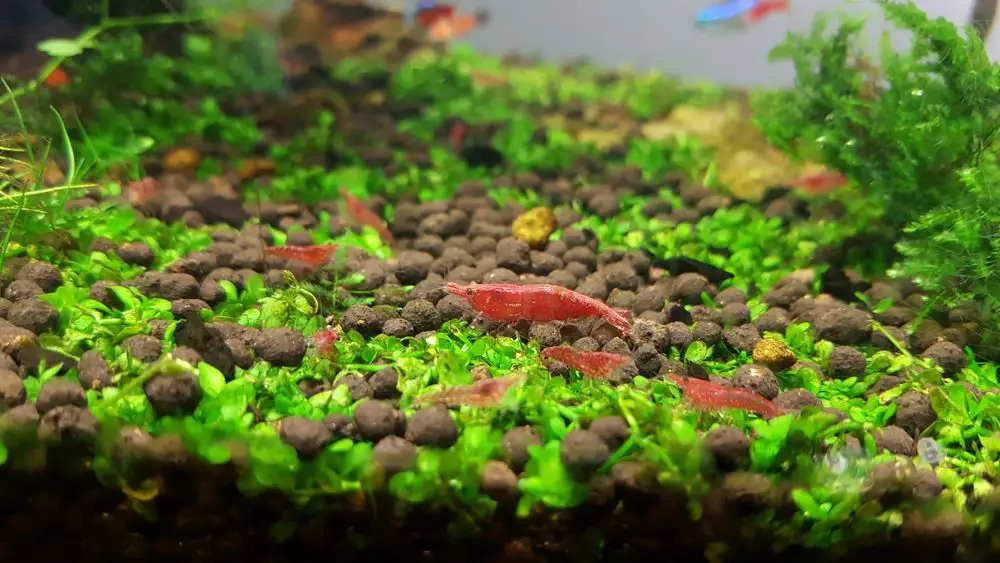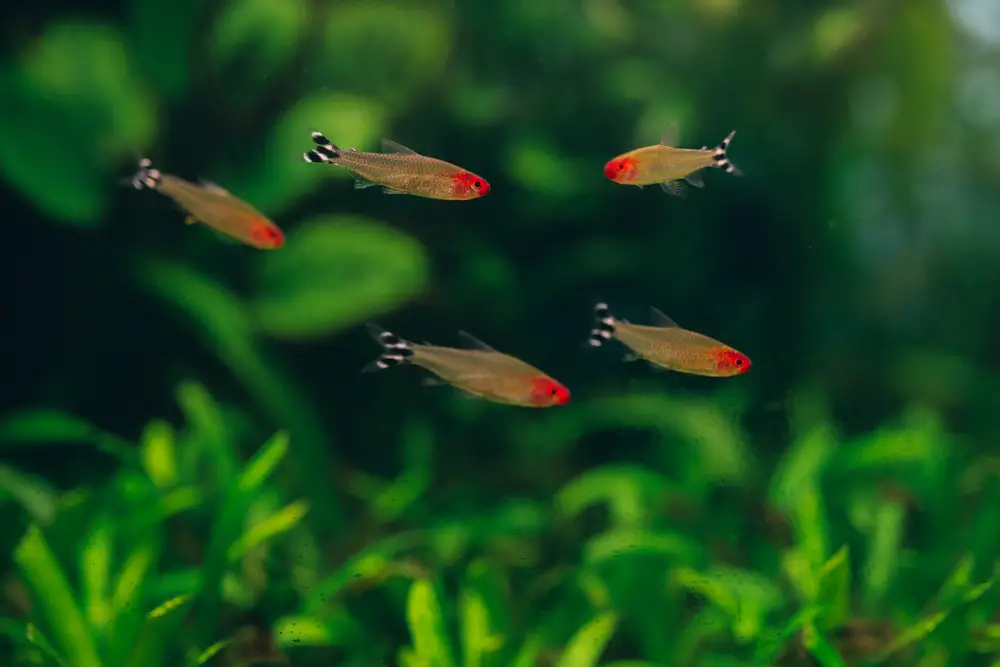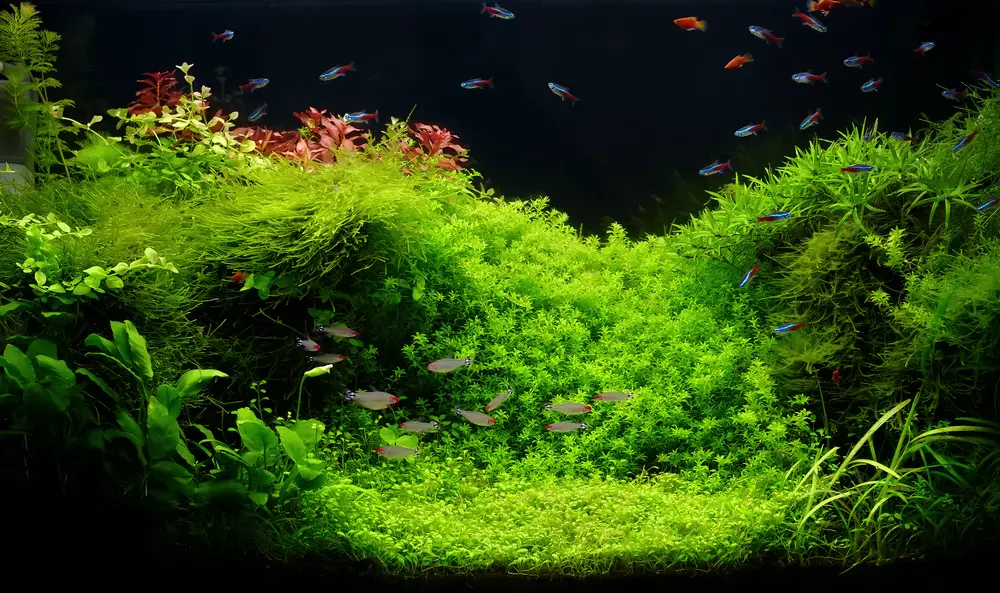Ever found yourself staring at your vibrant Red Cherry Shrimp, wondering if they could share their home with the elegant Rummy Nose Tetra? Imagine the dance of colors and the harmony of life, but wait – will they get along, or will it turn into a battle of survival?
Yes, with careful planning and attention to detail, Rummy Nose Tetras and Red Cherry Shrimp can coexist. But it’s not a shrimp-walk in the park!
I remember the first time I tried to introduce Rummy Nose Tetras to my Red Cherry Shrimp tank. The excitement, the anticipation, and then the realization – it’s not as simple as it seems. The Tetras were curious, maybe a bit too curious about their new tank mates.
The challenges were many: finding the right balance of vegetation, ensuring hiding spots for the shrimplets, and maintaining the perfect water parameters. It took months of trial and error, adjustments, and close observations. But after a year of persistence, I found the harmony I was looking for.
From dense vegetation to choosing the right shrimp species like tigers or Baubalti, the journey was filled with learning and growth.
The experience taught me that it’s possible but requires patience, attention, and a willingness to adapt. It’s a dance of nature that can be beautiful and complex, just like the intricate ballet of the shrimp and fish.
So remember, all fish will try and eat anything that fits in their mouths, including cherry shrimp; this post is about how you can reduce the chances of predation through careful use of plants and ensuring your Rummy Nose Tetra are correctly fed, so let’s dive in!

How can Rummy Nose Tetras and Red Cherry Shrimp coexist in the same tank?
Coexisting Rummy Nose Tetras and Red Cherry Shrimp in the same tank is a delicate dance that requires careful planning, understanding, and attention to detail. It’s not just about putting them together and hoping for the best; it’s about creating a harmonious environment where both species can thrive.
First and foremost, the tank must be designed with both species in mind. This means providing dense vegetation and moss that offer hiding spots for the shrimplets, ensuring that the Tetras cannot enter these safe zones. The choice of shrimp species can also make a difference; larger Caradina species like tigers or Baubalti may be more suitable for cohabitation.
Water parameters play a crucial role in this coexistence. Finding the right balance that caters to both species is essential, and regular monitoring and adjustments may be necessary.
The Tetras’ natural curiosity toward their new tank mates must be considered, and their behavior must be closely observed to ensure that they are not aggressively seeking out the shrimp.
Patience and attention are key in this process. It’s not a quick fix but a journey of understanding both species’ needs, behaviors, and preferences.
With enough care and consideration, Rummy Nose Tetras and Red Cherry Shrimp can indeed coexist in the same tank, creating a vibrant and lively aquatic community. It’s a rewarding experience for those willing to invest the time and effort, offering a glimpse into the intricate ballet of nature.
What are the key considerations for maintaining water parameters when keeping Rummy Nose Tetras with Red Cherry Shrimp?
Maintaining water parameters when keeping Rummy Nose Tetras with Red Cherry Shrimp is a nuanced task that requires a deep understanding of the specific needs of both species. It’s not just about keeping the water clean; it’s about creating a stable environment where both species can flourish.
One of the primary considerations is the pH level. Red Cherry Shrimp often thrive in higher pH levels while Rummy Nose Tetras prefer a slightly acidic environment. Finding a balance that caters to both can be challenging but is essential for their well-being. Regular monitoring and careful adjustments using appropriate water conditioners can help maintain the desired pH range.
Temperature is another vital factor. Both species require a stable temperature that doesn’t fluctuate drastically. Investing in a reliable heater and regularly checking the temperature can ensure that it stays within the optimal range for both the Tetras and the shrimp.
and regularly checking the temperature can ensure that it stays within the optimal range for both the Tetras and the shrimp.
Water hardness and mineral content are also essential to consider. Both species have specific preferences for water hardness, and understanding these needs can guide the choice of water conditioners and supplements. Regular testing for GH (General Hardness) and KH (Carbonate Hardness) can provide insights into the water’s mineral content and guide necessary adjustments.
The introduction of plants and other natural elements can also impact water parameters. Plants can absorb certain minerals and nutrients, affecting the water’s overall balance. Choosing plants that complement the needs of both the Tetras and the shrimp, and understanding how they interact with the water parameters, can create a more harmonious environment.
Regular water changes are a fundamental part of maintaining stable water parameters. However, these changes must be done with care, ensuring that the new water matches the existing parameters as closely as possible. Sudden changes can cause stress and harm to both species.
Maintaining water parameters when keeping Rummy Nose Tetras with Red Cherry Shrimp is a multifaceted task that requires ongoing attention, understanding, and care. It’s not just about numbers and measurements; it’s about creating a living ecosystem where both species can thrive. It’s a delicate balance that, when achieved, offers a rewarding and beautiful aquatic experience.

How to create a habitat that ensures the safety of shrimplets when keeping Rummy Nose Tetras?
Creating a habitat that ensures the safety of shrimplets when keeping Rummy Nose Tetras is an art that combines understanding, creativity, and careful planning. It’s about designing a space that caters to the needs of both species, allowing them to coexist without threatening the delicate shrimplets.
The key to this habitat is providing ample hiding spots for the shrimplets. Dense vegetation and moss can create natural barriers that the Tetras cannot penetrate, offering safe havens for the shrimplets to hide and grow. The choice of plants is essential here, as they must provide enough cover without hindering the movement and comfort of the Tetras.
Using specific structures like Cholla wood , coupled with mosses that are big enough for baby shrimps to hide in but small enough for fishes to stay out, can add another layer of protection. These natural elements enhance the aesthetic appeal of the tank and provide functional benefits for the shrimplets.
, coupled with mosses that are big enough for baby shrimps to hide in but small enough for fishes to stay out, can add another layer of protection. These natural elements enhance the aesthetic appeal of the tank and provide functional benefits for the shrimplets.
The positioning of these hiding spots is also crucial. They must be strategically placed to offer the shrimplets easy access without exposing them to unnecessary risks. Observing the behavior of both the Tetras and the shrimp can provide insights into the best locations for these safe zones.
Water parameters must also be considered in this habitat design. As previously discussed, finding the right balance that caters to both species is essential. Regular monitoring and adjustments can ensure that the water remains conducive to the growth and safety of the shrimplets.
The introduction of the Tetras must be done with care and consideration. Building a solid breeding colony of shrimp prior to introducing the fish can provide a buffer, ensuring that the population remains stable even if some shrimplets become prey.
Finally, ongoing observation and adaptation are vital. The needs and behaviors of both species can change over time, and the habitat must evolve with them. Regular checks, adjustments, and even redesigns may be necessary to ensure the ongoing safety of the shrimplets.
Creating a habitat that ensures the safety of shrimplets when keeping Rummy Nose Tetras is a complex but rewarding task. It requires a deep understanding of both species, a creative approach to design, and a willingness to adapt and evolve. It’s a journey that offers endless opportunities for learning and growth, culminating in a vibrant and harmonious aquatic community.
What are the common mistakes to avoid when introducing Rummy Nose Tetras to a Red Cherry Shrimp tank?

Introducing Rummy Nose Tetras to a Red Cherry Shrimp tank is an exciting venture but fraught with potential pitfalls. Understanding common mistakes and how to avoid them can make the difference between a thriving community and a disastrous clash.
One of the most common mistakes is rushing the introduction. It’s tempting to add the Tetras to the shrimp tank and hope for the best, but this can lead to aggression and stress for both species. Proper acclimation, including gradual adjustment to water parameters and careful observation of behavior, is essential for a smooth introduction.
Another mistake is failing to provide adequate hiding spots for the shrimplets. Without safe havens, the shrimplets are exposed to the curiosity and potential predation of the Tetras. Dense vegetation, moss, and strategically placed structures can offer the necessary protection, and neglecting this aspect can lead to a decline in the shrimp population.
Ignoring the specific water parameter needs of both species is another common error. As discussed earlier, finding the right balance of pH, temperature, and mineral content is crucial for the well-being of both the Tetras and the shrimp. Regular monitoring and adjustments are necessary, and overlooking this aspect can lead to an unhealthy and unstable environment.
Failing to observe and adapt to the behavior of both species can also lead to problems. Every tank and its inhabitants are unique; what works in one situation may not work in another. Ongoing observation, understanding the specific needs and behaviors of the Tetras and shrimp in your tank, and being willing to make necessary adjustments are vital for success.
Finally, unrealistic expectations can lead to disappointment and frustration. Introducing Rummy Nose Tetras to a Red Cherry Shrimp tank is not a simple task, and expecting immediate harmony without effort is unrealistic. Patience, attention, and a willingness to learn and adapt are essential for creating a successful cohabitation.
Introducing Rummy Nose Tetras to a Red Cherry Shrimp tank is a complex process that requires careful planning, understanding, and ongoing attention. Avoiding these common mistakes can pave the way for a vibrant and harmonious aquatic community, offering endless enjoyment and a rewarding glimpse into the delicate dance of nature. It’s a journey worth taking, but one that must be undertaken with care and consideration.

Conclusion: Can I keep Rummy Nose Tetra with Red Cherry Shrimp?
In summary, keeping Rummy Nose Tetras with Red Cherry Shrimp is possible but requires careful planning, understanding, and ongoing attention. From creating a harmonious habitat to maintaining the right water parameters, the journey is filled with complexities and nuances. Avoiding common mistakes and being willing to adapt and learn are key to success.
Ultimately, it’s a rewarding experience that offers a vibrant and lively aquatic community, reflecting the delicate dance of nature. It’s not a task to be undertaken lightly, but with patience and care, it can bring endless enjoyment and satisfaction.
Please don’t hesitate to reach out if you need any help or have any questions. If you can’t find me here, check out Aquarium Shrimp Keeping on Facebook.
Happy Shrimp and Tetra Keeping, Shrimpfam!
FAQ Section
Q. Can Rummy Nose Tetra live with cherry shrimp?
A. Yes, Rummy Nose Tetras can live with cherry shrimp, but it requires careful planning, proper tank setup, and attention to water parameters to ensure a harmonious coexistence.
Q. Will tetras eat Red Cherry Shrimp?
A. Tetras, including Rummy Nose, may show curiosity towards Red Cherry Shrimp, especially the shrimplets. While they typically don’t prey on adult shrimp, providing hiding spots and monitoring behavior is essential to prevent potential issues.
Q. What tetras are shrimp friendly?
A. Many small and non-aggressive Tetras, such as Neon Tetras and Ember Tetras, are considered shrimp friendly. However, individual behavior can vary, and careful observation and proper tank setup are key to successful cohabitation.
Q. Will tetras eat baby cherry shrimp?
A. Tetras may eat baby cherry shrimp, known as shrimplets, if they can find them. Providing ample hiding spots and dense vegetation can help protect the shrimplets and minimize this risk.
Q. What fish can you have with cherry shrimp?
A. Many small, non-aggressive fish can coexist with cherry shrimp, including certain Tetras, Guppies, and Rasboras. Understanding the specific needs and behaviors of both the shrimp and the fish, and creating a suitable habitat, is essential for successful cohabitation.
